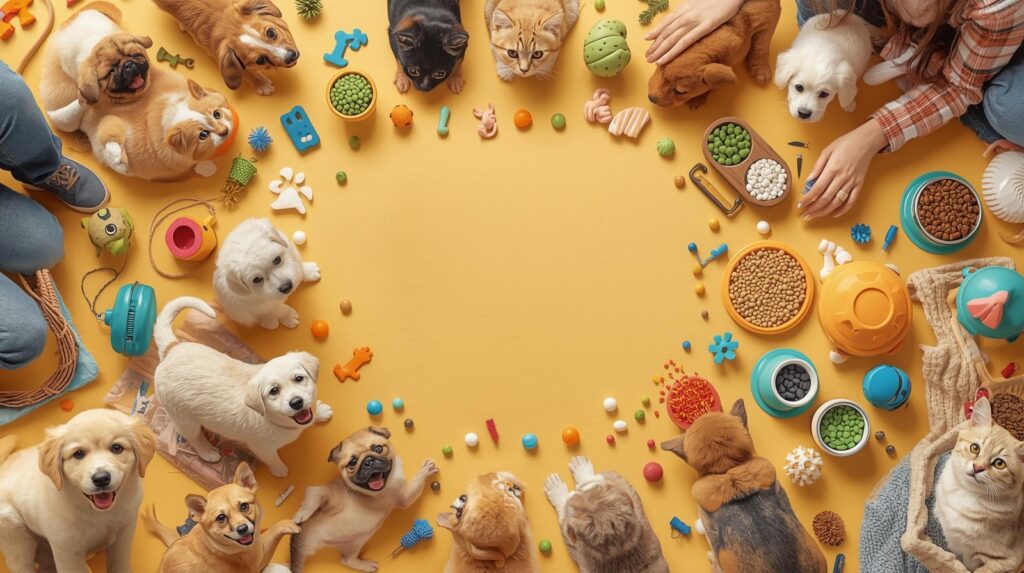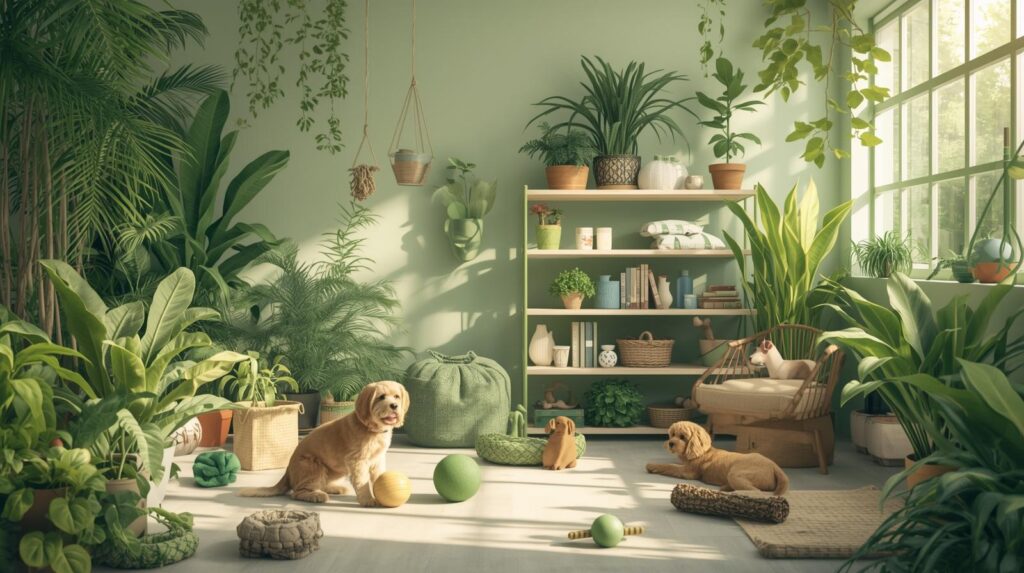Hey, pet lovers! The pet industry is booming, with millions of us pampering our furry pals like family. But it’s also getting a green glow-up, with eco-friendly products making it easier to care for our pets and the planet at the same time. Picture this: I’m sitting on my couch, my cat purring beside me, and I’m stoked to share how these sustainable goodies are changing the game. Let’s dive in, like we’re chatting over coffee about our dogs, cats, or even hamsters.
Eco-friendly pet industry products are all about loving our pets without hurting the Earth. Think toys, beds, or poop bags made from stuff like recycled plastic, bamboo, or materials that break down naturally. I got my dog a chew toy from recycled rubber, and he goes wild for it—same joy, less guilt. These products cut down on waste and keep harmful chemicals away from our furry friends.

What Exactly Are Eco-Friendly Pet Products?
So, what do we mean by eco-friendly pet products? Basically, these are items designed to minimize harm to the environment. We’re talking about stuff made from sustainable materials that break down naturally or get recycled easily. Think dog toys from recycled rubber, cat scratchers from cardboard instead of plastic, or leashes woven from hemp. I remember when I first heard about them—I thought they’d be flimsy or expensive. But nope, many are just as durable as the old stuff.
For instance, biodegradable poop bags are a game-changer. Regular plastic ones take forever to decompose, but these dissolve in landfills within months. My neighbor switched to them for her daily walks with her labradoodle, and she says it’s one less guilt trip every time she picks up after him. It’s simple things like this that add up.
Why Is the Pet Industry Going Green Now?
The pet industry isn’t changing overnight for fun—it’s because of us, the owners. More people are aware of climate issues, and since pets are like kids to many, we want products that align with our values. Surveys show that over 70% of pet owners prefer sustainable options if they’re available. Companies are listening because it makes business sense too. Producing eco-friendly items can reduce waste in manufacturing and appeal to a growing market.
Take pet food, for example. Traditional meat-based kibble uses tons of resources like water and land. Now, brands are offering plant-based or insect-protein alternatives that have a smaller carbon footprint. I tried insect-based treats for my cat once—he sniffed them suspiciously at first but devoured them. It’s cool how innovation meets necessity here.
In my opinion, this shift is long overdue. Pets bring joy, but their stuff contributes to pollution. If we can fix that without compromising quality, why not? It’s like choosing reusable bags at the grocery store—small habit, big impact.
Everyday Examples That Are Making Waves
Let’s get specific with some products I’ve seen or used. First, toys: There’s this brand that makes balls from natural rubber sourced sustainably. My dog’s old tennis balls would shred and end up in the trash, but these last longer and biodegrade if lost in the yard. Another fave is organic cotton chew ropes. They’re free from dyes that could irritate skin, and when they’re done, you can compost them.
Beds and bedding are another area. I upgraded my elderly dog’s bed to one filled with recycled polyester from plastic bottles. It’s soft, supportive, and hypoallergenic. Plus, it washes easy. For cats, eco-friendly litter from recycled paper or wood pellets clumps well and doesn’t track everywhere like clay does. A friend with three cats swears by it—less dust, better for asthma sufferers.
Grooming products too! Shampoos with natural ingredients like oatmeal and aloe, packaged in recyclable bottles. No harsh chemicals means safer for pets and rivers. And collars? Bamboo or cork ones are lightweight and antimicrobial. I switched my pup’s collar last year, and it’s held up through mud puddles and park romps.
Even pet furniture is going green. Cardboard cat castles that recycle into new boxes, or dog houses from reclaimed wood. These aren’t just gimmicks; they’re practical and fun.
The Real Benefits for Your Pet and the Environment
Why bother? Well, benefits are plenty. For pets, eco-products often mean fewer toxins. Synthetic materials can leach chemicals, but natural ones reduce allergy risks. My vet mentioned that some plastics off-gas stuff that irritates paws or noses—switching helped my dog’s itchy skin.
For the planet, it’s about reducing waste. The pet industry generates millions of tons of trash yearly from discarded toys and packaging. Eco-options cut that down. Biodegradable items decompose without releasing methane in landfills. Sustainable sourcing preserves habitats—think less deforestation for palm oil in treats.
There’s a health angle for us humans too. Cleaner products mean less pollution in our homes. And economically, while some cost more upfront, they last longer, saving money over time. Imagine not buying new toys every month because the eco one holds up.
A warning though: Not all are perfect. Some biodegradable bags need specific composting conditions to break down fully. Always read labels to avoid false hopes.
My Personal Opinion: This Is More Than a Fad
Honestly, I love this trend—it’s empowering. As a pet owner, I feel guilty sometimes about the waste my two cats create with their litter alone. Going eco eases that. It’s not about being perfect; it’s progress. I started small, like with reusable food mats instead of disposable liners. Now, it feels natural.
In my view, companies leading this are heroes. Brands like The Honest Kitchen or Beco Pets aren’t just profiting; they’re educating. They share carbon footprint info, which helps us make informed choices. If more follow, the whole industry improves. But consumers drive it—keep demanding, and supply grows.
Practical Tips to Pick the Right Products
Ready to shop? Here’s how to choose wisely. First, check certifications like USDA Organic or FSC for wood. These ensure claims are legit.

Compare materials: Opt for bamboo over plastic—it’s renewable and strong. Read reviews from real users; forums like Reddit’s r/petproducts have honest feedback.
Budget tip: Start with high-waste items like poop bags or toys. They’re affordable entry points. Look for sales on sites like Amazon or Petco’s green section.
For food, transition slowly to avoid tummy upsets. Mix new sustainable kibble with old over a week.
And involve your pet—test a toy to see if they like it. My cat ignored a fancy eco-scratcher at first, but catnip fixed that!
Beware of Greenwashing: Don’t Get Fooled
Here’s a heads-up: Not everything labeled “eco” is truly friendly. Greenwashing is when companies exaggerate claims. For example, a toy might say “natural” but contain hidden plastics. Or “biodegradable” without specifying how long it takes.
How to spot it? Look for vague words like “earth-friendly” without backups. Check the company’s sustainability report. If they hide ingredients, skip it.
I fell for this once—a “recycled” bed that shed microplastics. Lesson learned: Research via apps like Think Dirty for product scans.
A Real-Life Story to Inspire You
Let me share about my buddy Mike. He has a hyper golden retriever that chews everything. Traditional toys lasted days, piling up trash. He switched to eco-rubber bones from a sustainable brand. Not only do they endure, but Mike composts the bits when worn. His vet bills dropped too because no splinter risks. Now, he advocates at the dog park, and a few friends followed suit. It’s proof—one person’s change sparks a chain.
FAQs to Clear Up Common Questions
Are eco-pet products pricier?
Often yes, by 10-20%, but deals exist, and longevity balances it.
Safe for all pets?
Mostly, but puppies might need tougher materials. Consult vets for allergies.
Where to buy?
Local pet stores, online giants, or direct from brands like West Paw.
Do they work as well?
Absolutely—in many cases, better. Natural litters control odors great.
Can I make DIY versions?
Sure! Old t-shirts into tug toys, or baked sweet potato treats.
What if my pet hates them?
Return policies help; ease in gradually.
Potential Drawbacks and How to Handle Them
No rose without thorns. Some eco-materials wear faster in extreme use—like a heavy chewer on plant-based toys. Solution: Choose reinforced options or supervise play.
Availability can be spotty in rural areas. Online shopping fixes that, though shipping adds carbon—opt for bulk or local if possible.
For seniors or special needs pets, ensure comfort. Memory foam from recycled sources works wonders.
Overall, pros outweigh cons if you pick smart.
How to Get Started Without Overwhelm
- Don’t stress—start easy. Assess your pet’s basics: What do you buy most? Toys? Food? Target one.
- Week one: Swap poop bags. Week two: Try a new toy. Track savings or pet reactions in a note app.
- Involve family—kids love “green missions” like recycling old toys.
- Join communities: Apps or groups share deals and reviews.
- Benefit: You’ll feel proactive, and your pet gets quality stuff.
The Bigger Picture: Industry Impact
This reshape goes deep. Factories adopt green practices, reducing water use by up to 50% in some cases. Jobs in sustainable sourcing grow. Even packaging shrinks—less plastic wrap means less ocean pollution.
Warnings for the future: If demand slacks, progress stalls. Stay engaged—vote with your wallet.
Conclusion: Your Takeaways for a Greener Pet Life
Wrapping up, eco-friendly products are truly reshaping the pet industry for the better. They offer safer, sustainable options that benefit pets, owners, and Earth. From my experience, starting small leads to big habits.
Key advice: Research, start with one swap, and watch for greenwashing. Tips like checking labels and reading reviews will guide you. Remember, every biodegradable bag or recycled toy counts toward less waste.
Make the switch today—your pet will thank you with wags or purrs, and you’ll sleep better knowing you’re part of the solution. Let’s keep loving our pets without costing the planet. What’s your first green pet buy going to be?
